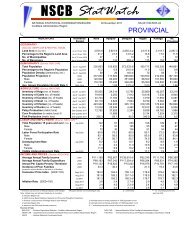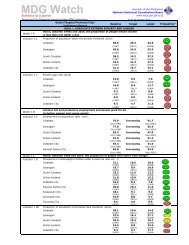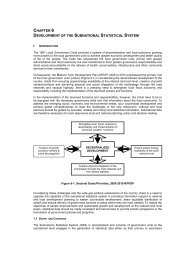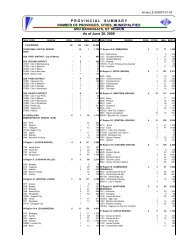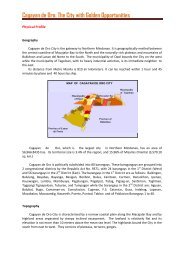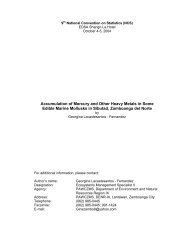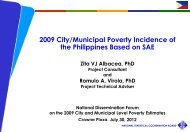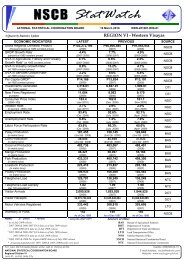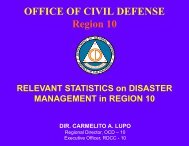Naval: Home to the amazing Higatangan Island - NSCB
Naval: Home to the amazing Higatangan Island - NSCB
Naval: Home to the amazing Higatangan Island - NSCB
Create successful ePaper yourself
Turn your PDF publications into a flip-book with our unique Google optimized e-Paper software.
<strong>Naval</strong>: <strong>Home</strong> <strong>to</strong> <strong>the</strong> <strong>amazing</strong> <strong>Higatangan</strong> <strong>Island</strong><br />
<strong>Naval</strong> is <strong>the</strong> capital <strong>to</strong>wn of Biliran<br />
Province, <strong>the</strong> smallest among <strong>the</strong> six<br />
provinces of Eastern Visayas. It is also<br />
<strong>the</strong> seat of <strong>the</strong> provincial government.<br />
The quaint municipality is <strong>the</strong> center of<br />
education, trade and commerce, and<br />
also religion, where <strong>the</strong> Ca<strong>the</strong>dral of<br />
<strong>the</strong> Diocese of <strong>Naval</strong> is situated<br />
covering <strong>the</strong> entire province and some<br />
o<strong>the</strong>r five municipalities of Leyte island.<br />
<strong>Naval</strong> is home <strong>to</strong> <strong>the</strong> <strong>amazing</strong><br />
<strong>Higatangan</strong> <strong>Island</strong>, famous for its<br />
moving sand bar and rock formations.<br />
<strong>Higatangan</strong> <strong>Island</strong>, <strong>Naval</strong>, Biliran<br />
<strong>Naval</strong> plays a very important role in <strong>the</strong> local <strong>to</strong>urism industry. The locality primary<br />
caters <strong>to</strong> services for inns, dining cafes and restaurants, on transportation, shopping<br />
and entertainment.<br />
Demography The capital <strong>to</strong>wn registered a <strong>to</strong>tal population of 44,288 in <strong>the</strong> 2007<br />
Census of Population. Its population density of 409 persons per square kilometer is<br />
<strong>the</strong> highest among <strong>the</strong> 8 municipalities of Biliran Province. The people are<br />
predominantly Roman Catholic and Cebuano speaking.<br />
His<strong>to</strong>ry According <strong>to</strong> <strong>the</strong> old folklore, <strong>the</strong> original settlers of <strong>Naval</strong> were Cebuanos,<br />
coming from Danao, Cebu through <strong>the</strong> efforts of Padre Inocentes Mangco Garcia during<br />
<strong>the</strong> later half of <strong>the</strong> 18 th century. Padre Garcia used <strong>to</strong> pass by <strong>Naval</strong> during his trips<br />
from Biliran <strong>to</strong> Almeria. As<strong>to</strong>unded by <strong>the</strong> plains and <strong>the</strong> fertility of <strong>the</strong> place, he<br />
invited over his relatives from Cebu and eventually settled <strong>the</strong>re.<br />
Even before <strong>the</strong> area was inhabited, <strong>the</strong> place was already called “Bagazumbol”. The<br />
original words came from <strong>the</strong> Samareño word which means somewhat pointed. As he<br />
traveled from Biliran <strong>to</strong> Almeria, <strong>the</strong> late Padre would always say he is heading for a<br />
place beyond “Bagazumbol”.<br />
The next wave of settlers came from Bohol, Panay and Negros. The land was divided<br />
among <strong>the</strong> Cebuanos, Boholanos, and <strong>the</strong> Ilongos. Cebuanos were given <strong>the</strong> land<br />
south of <strong>the</strong> settlement stretching <strong>to</strong>wards Caraycaray. The Boholanos occupied <strong>the</strong><br />
land just beyond <strong>the</strong> canal at Calumpang stretching <strong>to</strong> <strong>the</strong> mountain. Ilongos settled<br />
on <strong>the</strong> north, <strong>to</strong>wards <strong>the</strong> Anas River.
Geography <strong>Naval</strong> is located on <strong>the</strong><br />
west coast of Biliran Province and is<br />
bounded on <strong>the</strong> north by <strong>the</strong><br />
municipality of Almeria, on <strong>the</strong><br />
nor<strong>the</strong>ast by Culaba, on <strong>the</strong> east by<br />
Caibiran and Cabucgayan, while down<br />
south by <strong>the</strong> municipality of Biliran. On<br />
its west is <strong>the</strong> Biliran Strait, and<br />
adjacent is <strong>the</strong> tip nor<strong>the</strong>rn part of<br />
Leyte and going beyond is <strong>the</strong> Visayan<br />
Sea.<br />
It has <strong>the</strong> biggest land area of 108<br />
square kilometers among <strong>the</strong> 8<br />
municipalities, and is composed of<br />
twenty-six (26) barangays.<br />
Topography The municipality is characterized as a plain coastal lowland where human<br />
habitation is concentrated. Rolling hills dominate <strong>the</strong> eastern part of <strong>the</strong> <strong>to</strong>wn, with two<br />
high mountains, Campoding and Sayaw, elevated above sea level at 437 meters and 900<br />
meters, respectively. There are three o<strong>the</strong>r mountains in common boundary location with<br />
Caibiran and Culaba.<br />
Climate September is <strong>the</strong> municipality’s most rainy month with an average of 336.6<br />
millimeters precipitation while April is <strong>the</strong> municipality’s driest month with an average of<br />
74.3 millimeters precipitation. The municipal climate is healthful and invigorating having<br />
an average temperature of 27 degrees centigrade.<br />
Financial Resources <strong>Naval</strong> is classified as 2nd class municipality with an average<br />
annual income of P50.58 million from 2004-2007. The Internal Revenue Allotment (IRA) of<br />
<strong>the</strong> municipality amounted <strong>to</strong> P55.9 million in 2009. This translates <strong>to</strong> an IRA per capita of<br />
P1,261, <strong>the</strong> smallest among <strong>the</strong> eight municipalities due <strong>to</strong> its big population.<br />
Education As <strong>the</strong> center of education, <strong>Naval</strong> has a <strong>to</strong>tal of 27 government elementary<br />
schools, 4 government secondary schools, 3 private elementary schools, and 2 private<br />
secondary schools in SY 2009-2010. It has also <strong>the</strong> lone tertiary school serving <strong>the</strong> whole<br />
province.<br />
Health <strong>Naval</strong> has 1 government hospital with 25 bed capacity, 3 barangay health<br />
centers, 25 physicians, 32 nurses, 2 dentists, 12 midwives, and 221 barangay health<br />
workers catering <strong>to</strong> medical and health care needs of <strong>the</strong> populace.<br />
Socio-Economic Activities <strong>Naval</strong> is an agricultural <strong>to</strong>wn with rice as <strong>the</strong> primary<br />
product. With its vast rice fields, <strong>the</strong> local produce is more than enough for local<br />
consumption. Copra is also abundant in <strong>the</strong> locality, but with <strong>the</strong> absence of a local<br />
processing plant, this product has <strong>to</strong> be transported <strong>to</strong> <strong>the</strong> nearby cities of Tacloban and<br />
Cebu. Horticulture is now an emerging business in <strong>Naval</strong> as <strong>the</strong> demand is significantly<br />
increasing. The <strong>to</strong>wn is also rich in marine resources, with Biliran Strait and Visayan Sea<br />
as major fishing grounds.
<strong>Higatangan</strong> <strong>Island</strong> <strong>Naval</strong>’s wellkept<br />
treasure is <strong>Higatangan</strong> <strong>Island</strong>,<br />
famous for its shifting sand bar extending<br />
about 200 meters <strong>to</strong> <strong>the</strong> sea, studded<br />
with giant clamshells and o<strong>the</strong>r exotic<br />
seashells. The island showcases pristine<br />
white sand beaches with crystal clear<br />
blue seawater with a wide array of coral<br />
reefs. <strong>Higatangan</strong> <strong>Island</strong> also takes pride<br />
of its as<strong>to</strong>nishing rock formations carved<br />
through time by <strong>the</strong> Visayan Sea.<br />
Cavin<strong>to</strong>ng Cave is situated far north,<br />
which is home <strong>to</strong> many bats.<br />
The island is about 30 <strong>to</strong> 45 minutes mo<strong>to</strong>rboat ride from <strong>Naval</strong> <strong>to</strong> Mabini or Libertad Port.<br />
Although <strong>Naval</strong> is <strong>the</strong> most convenient access point, <strong>the</strong> island can also be reached via San<br />
Isidro, Leyte and Maya or Tapilon, Cebu through special/private trips. <strong>Higatangan</strong> <strong>Island</strong><br />
Beach Resort offers a fast mo<strong>to</strong>rboat available for pick up services.<br />
Accommodation Facilities <strong>Naval</strong><br />
plays a very important role in <strong>the</strong> local<br />
<strong>to</strong>urism industry. The locality primary<br />
caters <strong>to</strong> services for inns, dining cafes and<br />
restaurants, on transportation, shopping<br />
and entertainment. List of hotels/resorts<br />
include Biliran Garden Resort, <strong>Higatangan</strong><br />
<strong>Island</strong> Beach Resort, Marvin’s Seaside Inn,<br />
Brigida Tourist Inn, TJ Lodge, V&C Lodge,<br />
Rose Marie Apartelle, Rosevic Executive<br />
Lodging House, and D’ Jan Dell’s Cabin.<br />
Getting There <strong>Naval</strong> can be reached both by land and sea travel. It is 122 and 88<br />
kilometers away by land travel from <strong>the</strong> cities of Tacloban and Ormoc, respectively. Travel<br />
time from <strong>the</strong>se two cities would only take an average of about 2 hours in shuttle vans or<br />
regular buses. Scheduled trips going <strong>to</strong> and from Tacloban has an interval of 30 minutes<br />
starting at 4 o’clock in <strong>the</strong> morning until 5 in <strong>the</strong> afternoon. By sea, three cargo/passenger<br />
vessels ply <strong>the</strong> route between <strong>Naval</strong> and Cebu City daily, except Mondays and Saturdays,<br />
with a travel time of about 10 hours. Travelers from Cebu may opt <strong>to</strong> take <strong>the</strong> daily trips<br />
of a fast ferry plying between Cebu and Ormoc that only takes about 2 hours. From<br />
Ormoc, a daily scheduled trip is available with an interval of about 2 hours.<br />
References:<br />
Department of Education, Biliran Division<br />
Department of Budget Management, Regional Office VIII<br />
Bureau of Local Government Finance, Regional Office VIII<br />
Leyte & Biliran <strong>Island</strong>s Brochure, Department of Tourism, Regional Office VIII<br />
2008 Municipal Socio-Economic Profile, MPDO <strong>Naval</strong><br />
2009 Regional Social and Economic Trends for Eastern Visayas, <strong>NSCB</strong><br />
http://www.leytetravel.com<br />
Pho<strong>to</strong>s courtesy of <strong>the</strong> Department of Tourism, Region VIII<br />
<strong>Naval</strong>: <strong>Home</strong> <strong>to</strong> <strong>the</strong> <strong>amazing</strong> <strong>Higatangan</strong> <strong>Island</strong><br />
A Municipal Profile<br />
is prepared by <strong>the</strong> Regional Division VIII<br />
of <strong>the</strong> NATIONAL STATISTICAL COORDINATION BOARD (<strong>NSCB</strong>)<br />
14 May 2010<br />
For your information needs, please contact us at: (053) 325-7508<br />
email us at nscbru8@yahoo.com<br />
or log on <strong>to</strong> www.nscb.gov.ph/ru8



